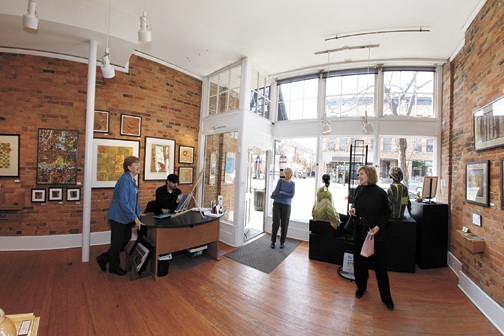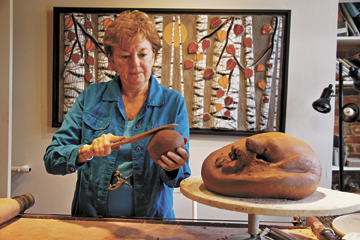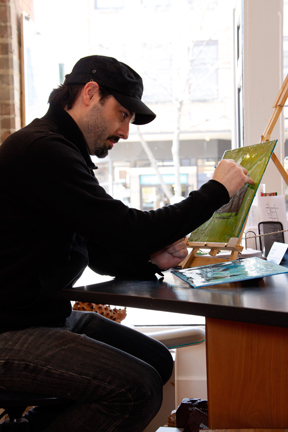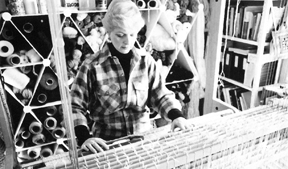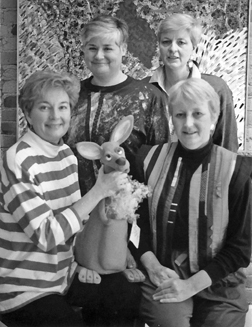
Columbus, Ohio USA
Return to Homepage www.shortnorth.com
Studios on High
Showcasing artistic diversity for 25 years
By Karen Edwards
April 2011 Issue
Return to Homepage
Photos © Larry Hamill
Persevering despite the odds, Studios on High, 686 N. High Street, Columbus’ oldest artist-owned and operated gallery. For 25 years, Studios on High has weathered its derelict surroundings, fluctuating art trends and economic downturns to become as much a part of the Short North landscape as the Mona Lisa mural. So what’s its secret? What has kept this little gallery at 686 N. High Street showcasing art for a quarter of a century?
You can credit, in part, Sandy Wood – the businessman who almost single-handedly shaped the Short North into a thriving arts community. In 1986, when a freshly renovated space became available at the 686 N. High location, it was Wood who wanted to carry on the artistic direction the Short North had taken. He wanted the space to become a gallery – and he made it happen.
Yet other art galleries have come and gone in the Short North. Why has Studios on High endured?
Ah, therein lies a tale – a small fable that may help explain the gallery’s longevity.
It begins six years after Studios on High opened its doors – and it involves a race. It was, in fact, to be the race of the year – the tortoise and the hare, competing once again as they did in Aesop’s story. This time, however, the race would be along that stretch of High Street that runs through the Short North and right past Studios on High.
Judy Hoberg, one of the owners of Studios on High, had arranged the spring event that would promote both the Short North and the gallery. Hoberg hired two university students to portray Aesop’s racers. She rented costumes and secured publicity for the event – but when the day of the race arrived, there was one small glitch. The two students Hoberg had hired, her tortoise and hare, changed their minds. They weren’t coming. But a television crew was, and would be there within the hour.
If you could choose two words to describe an artist, “creative” and “resourceful” might be among your top choices – and Hoberg is an artist. So, the news, while frustrating, didn’t slow her down a beat. She recruited fellow artist and gallery co-owner, Bonnie Valentine, and the pair quickly donned the costumes.
“I was the hare, Bonnie was the tortoise,” Hoberg recalls. “I had gigantic feet that were hard to manage and Bonnie had this huge shell.” Nevertheless, the pair took to the street, one on each side of the road.
“I hopped and tried to act like a rabbit and Bonnie tried her best to imitate a turtle,” Hoberg says. The event was a success and the race was shown on local newscasts. It’s still a favorite replay at the Hoberg house.
The moral of the story? Well, there are three ways this tale is relevant to Studios on High and its 25-year history.
First, it illustrates exactly what makes Studios on High different from other art galleries in the Short North. It is an artist cooperative, a place where each artist becomes a co-owner and contributes not just his or her art to the gallery space but also time, talent, energy, money – and participation in an occasional promotional event as well. “It’s a community,” explains Hoberg.
In a broader sense, though, the tortoise and hare are metaphors for the gallery itself. In a world of lightning speed, where individuals race against time and a complicated to-do list, art is a medium that emerges slowly, with concentration, attention, and care. It’s an invitation to slow down and reflect on the world and the human condition. For 25 years, Studios on High has been a place where that invitation is extended day after day, year after year, no matter the art or who is in charge.
Finally, Studios on High is one of those places that, like the tortoise, has progressed at its own pace over the last 25 years, persevering despite the odds. And in case you’re unfamiliar with Aesop’s tale – the tortoise eventually wins the race.
Gallery origins
Founding member Judy Hoberg has a working studio in the co-op. But back to the beginning, after Wood started to look for artists to fill the space.
It was Judy Hoberg, a ceramicist, who initially showed up at Wood’s door. Hoberg had been looking around town for studio space – but after attending several Gallery Hops in the Short North, she knew she had found a home. After all, the Short North, though still run-down and a bit derelict at that time, was beginning to emerge as an arts community – and Hoberg wanted to be a part of it. She began working with Wood to locate a property in the area.
When Wood brought her to the vacant location at 686 N. High St. – the space he wanted to become a gallery – Hoberg says she fell in love. “It had high ceilings, brick walls, a wooden floor. It was perfect.”
Artist Ruth Lantz thought so too. By the time Hoberg was ready to commit to a contract, Lantz had already rented the space, along with artist Marcia Armstrong.
At the time, Lantz was a weaver (she now knits) and she set up her looms in the front space. Armstrong, a potter, worked in the back.
But this was the ‘80s, and the Short North was still very much an urban landscape. That meant anyone could – and often did – walk through their doors.
“One day, a homeless woman came in and asked if she could eat her sandwich there,” says Lantz. “She said it would make her feel safer.” Lantz agreed, but during the impromptu “lunch hour,” the homeless woman asked Lantz if she wanted to see an animal she had with her. It was okay, the woman told Lantz. The animal was dead. Lantz declined.
“Prostitution was also thriving in the area then,” says Lantz. “I used to say that suburban women had no idea of the kinds of things we saw at work each day.”
The interruptions – and bizarre guests – proved to be too much for Armstrong. She left before the year was out, leaving Ruth with a space too large and too expensive for one artist. Lantz turned to Wood for help.
“I know just the person,” Wood told her.
Enter Judy Hoberg – who was happy to move into the studio and share the rent. Even then, however, there seemed to be too much space and not enough rent. So Hoberg sublet half of her area to artist Bonnie Valentine who works in mixed media. Although there had never been any intention to create the studio as an artist cooperative, that’s what happened. Not only were the three women supporting each other, but they were producing, displaying and selling three different art forms, and such diversity of art in one gallery proved to be a good draw for Studios on High.
We were always able to provide something fresh, something not seen before,” says Lantz. Soon, a steady stream of art lovers began to show up at the gallery. “We began to invite other artists into the cooperative,” says Hoberg. Not only did additional artists provide an increasing variety of art but it also helped create more comfortable rent and work arrangements for the gallery’s co-owners.
“Our rents went down, and we could increase the days and times we were open,” says Hoberg. Since artists often travel to shows and exhibits, “It meant we could still have gallery hours while one or more of us were on the road,” says Hoberg.
Carol Hershey, who joined the Studios in 1990 and stayed 14 years before opening the High Road Gallery in Worthington, says, back then, the studios were working studios and not just gallery space. “The lower costs and the flexibility really helped,” she says.
“We could have private lives again,” adds Lantz.By invitation only
Most SOHG artists work on a piece during their gallery “work hours,” allowing visitors to see art as it’s created. Ryan Orewiler is one of a half dozen members who are painters. Of course, not every artist was, or is, invited into the cooperative.
To maintain the gallery’s diversity (and to avoid competition among co-owners), the cooperative invites only artists working in a specific medium to apply.
That’s how Sandy Reddig came into the gallery. Six years ago, Studios on High was looking for a pastel artist.
“I had just completed a show in Worthington and Carol Hershey told me that Studios on High was looking for an artist in my medium,” says Reddig. “As soon as I heard about the position, I applied.”
Just because an artist happens to work in one of the hand-picked art forms, however, does not mean he or she is automatically assigned space on the wall. This is a juried gallery. The artist will need to come in for an interview – conducted by the gallery’s four-member board, and will need to bring in his or her art. Not photos of the art, the actual art itself. “When I came in for my interview, yep, I lugged in all of my paintings,” Reddig recalls.
Feedback will be solicited from other artists in the cooperative (they are typically referred to the artist’s Web site), then the invitation to join the Studios is extended, with a few caveats. Invited artists will need to commit to working in the gallery for six hours, one day per week. And as co-owners of Studios on High, they’re expected to do everything from manning the phones, to greeting visitors, to data entry, to cleaning.
“There are also a couple of hours per month of committee work,” says Reddig. Artists in the co-op are expected to serve on at least one committee, with topics ranging from publicity to event planning. If you don’t volunteer for a committee, one will be assigned. It’s all part of ownership responsibility, explains Reddig. Then there are general group meetings which occur on an as-needed basis, generally two or three times a year.
If the invited artist is willing meet the time requirements, he or she will become a co-owner of one of the longest-operating art galleries in the Short North.
Most artists do accept – and are there for five, fourteen, even 25 years, as in Hoberg’s case. “There isn’t much turnover,” says Reddig. Artists come and go for a variety of reasons – a move to another location, lack of time, retirement, or opening a new gallery, like Hershey.
Hershey says she modeled her High Road Gallery after the Studios on High concept. “It’s a not-for-profit gallery for the benefit of artists, and the visiting artist participates in the gallery while their work is on display.” They may bring in food for the opening, for example, and until recently, they took turns gallery-sitting, she says. Hershey, however, remains the gallery’s sole owner.
At Studios on High, membership is limited to just 18 artists – the optimum number for the gallery’s long, narrow space, says Hoberg. Most of those artists own working studios outside of the gallery (Hoberg is the only artist to have her working studio on site), but the gallery features two live demonstrations a month, and most artists typically work on a piece during their gallery “work hours,” so there is always an opportunity to visit with an artist and to see art as it’s created.
Lantz says the gallery has always sought to educate people about art and the process of creating it. That’s why the interaction between artists and visitors has always been an important aspect of the gallery, she says.Artists at work
Ruth Lantz opened Lantz/Armstrong Studios at 686 N. High St. in 1986 with Marcia Armstrong. Lantz was later joined by Judy Hoberg and Bonnie Valentine, beginning a long tradition of artist tenants for the cooperative gallery Studios on High. Reddig says it’s one of the reasons she loves to work there.
“One day, I was at the gallery and sketching a house portrait from a photograph,” says Reddig. A young man looked over her shoulder and began to ask questions about the process of drawing from a photograph. “He told me he had just returned from Afghanistan and was looking for an artist to sketch a picture from a photograph he had.” He showed her the photo. It featured the young man amid a few smiling Afghani children. They had twisted their bodies to shape the familiar “O-H-I-O.” Reddig says she was touched by the photo and that he thought enough of her art to ask about sketching the photo for him. Although nothing has been finalized yet, the two remain in contact with each other.
Like Reddig’s work, “Most of our art is on the traditional side,” says Hoberg. As a result, many visitors to the gallery say they feel an instant connection with the art that’s displayed.
“People will approach me, teary-eyed after seeing one of my animal portraits or even a house portrait,” says Reddig. “They’ll recall a home or a pet that was important in their own lives.”
Meeting the artists adds to the spirit of hospitality there, says Phil Jenkins, former owner of the Inn at Honey Run. Jenkins used to buy art for his business at Studios on High – and still buys pieces for his personal collection. “When I first visited the gallery seven years ago, I was blown away,” he says. “There was such a large assortment of art there.” Now, he says, he’s always eager to return, to see what’s new, and to visit with artists who have since become friends.
Linda Laine, another gallery regular, says she feels like an unofficial member of the co-op family. “Come to my house and you’ll see Studios on High,” she says with a laugh.
Laine says she buys one piece a year from jewelry designers Ken and Rachel Conner. “I’m addicted to Rachel’s work,” says Laine, who has had the artist custom-design pieces for her. “I tell people I don’t purchase the piece – I adopt it,” she says with another laugh.
Laine has also worked with Hoberg, who sculpted a statue of her dog, a Bijon Frise named Raisin. “I brought Raisin into the Studio one day and told Judy I didn’t know how much longer I’d have him.” Hoberg went to work, and now Laine has a permanent re-creation of her pet.
But Laine’s favorite Studios on High purchase may be her newest one – the large “Begging Deer” sculpture, created by ceramic artist Denise Romecki.
“I visited the Home and Garden Show last year and fell in love with a large deer sculpture. It was about my height – I’m five feet – had a beautiful form, and it came with a message,” says Laine. The deer held in its mouth a ball with a branch on it, to which was attached a single leaf. “The message,” says Laine, “was that the animal’s natural resources had become so depleted the deer had to go begging for food.”
Laine didn’t know who created the art, but shortly after the Home and Garden Show, she happened to visit Studios on High. “There were pieces there that looked similar to the deer, so I asked to see the artist’s portfolio.” Laine flipped through the pages, and there it was – The Begging Deer.
Laine contacted Romecki and asked if she could buy it. Romecki was initially reluctant to sell it and offered to make her a smaller version of it instead, but Laine was insistent. She is an extensive gardener, and her own home and garden were to be featured on a home tour to be held later this year. “I wanted it there for the tour, and I told her I would design a garden around it,” says Laine. It was an offer Romecki could not refuse. During one of Columbus’s frequent snow storms this past winter, she delivered the same statue Laine had fallen in love with a year before.Still a draw
Early members: (Back L-R) Bonnie Valentine, Ruth Lantz; (Front L-R) Judy Hoberg with whimsical critter, and Suzanne Evenson. Jenkins and Laine are examples of the thousands of customers who have fallen in love with Studios on High over its 25 years.
“Initially, we drew visitors from the suburbs who were looking for something different to do,” says Hoberg. The suburbanites, along with a few college students and fellow artists, made up those early gallery visitors. “The Gallery Hops were a huge benefit,” says Hershey. “They brought a lot of first-time visitors through our doors.”
But few were art collectors. “We had a few collectors,” says Hoberg, “but back then, Columbus wasn’t known for its art. Most collectors went to New York or Chicago.”
Today, that’s changed. Columbus is now the 10th largest art market in the country, and Studios on High draws visitors from all over the U.S., and international visitors as well.
“The Short North has a national reputation now,” says Lantz. “It’s bringing more tourists to the area.”
In addition, the studio sees a lot of convention traffic, says Hoberg. And, as the Short North continues to develop, with its high-rise urban housing, “We’re also seeing a lot more young professionals and retirees.”
The young professionals come to Studios on High for what is likely to be their first art purchase. The retirees, says Hoberg, are looking for change. They’ve lived with their art for years. A new place and new wall space motivates many retirees to look for new paintings, watercolor or sculpture.
And at Studios on High, with its inherent diversity, they’re likely to find just what they’re looking for.
Hoberg looks back over the past 25 years with pride and a quiet sense of relief. “It would be hard to open a gallery today, given the economy.”
But like the tortoise and the hare, the artists at Studios on High have learned the race belongs not just to the winner – but to those who choose to run the race at all.
Studios on High Gallery is located in the Short North Arts District at 686 N. High St. Open 7 days until 6 p.m. Visit www.studiosonhigh.com or call 614-461-6487 for more information.
CELEBRATION AT THE COLUMBUS CULTURAL ARTS CENTER
April 15 through May 11, 2011
Showcasing works by both current and past artists/members of SOHG
in celebration of 25 yearsOPENING RECEPTION
Friday, April 15 from 5:30 to 9pm
139 W. Main St. Downtown
The Public is Invited!Current SOHG Exhibiting Artists
Jeanie Auseon, Scott Conover,
Lisa Horkin, Kathy Grace,
Tom Harbrecht, Beth Himsworth,
Judy Hoberg, Marty Husted,
Debbie Jackson, Deb Johnson,
Ruth Ann Mitchell, Helen Neumann,
Ryan Orewiler, Sue Quellhorst,
Ken Conner, Rachel Conner,
Sandy Reddig, Denise Romecki,
Marcia Snedecor, Teda TheisAlumni Artists Exhibiting
Carol Neff, Fran Mangino, Katie Schmitt,
Clay Sneller, Bonnie Valentine,
Hollie Mion, Sue Shape, Jeff Hershey,
Meredith Martin, Rhonda Bartoe-Tucker,
Carol Hershey, Ann Cushman,
Jeff Shaw, Omar Shaheedwww.studiosonhigh.com
(614) 461-6487
© 2011 Short North Gazette, Columbus, Ohio. All rights reserved.
Return to Homepage www.shortnorth.com
